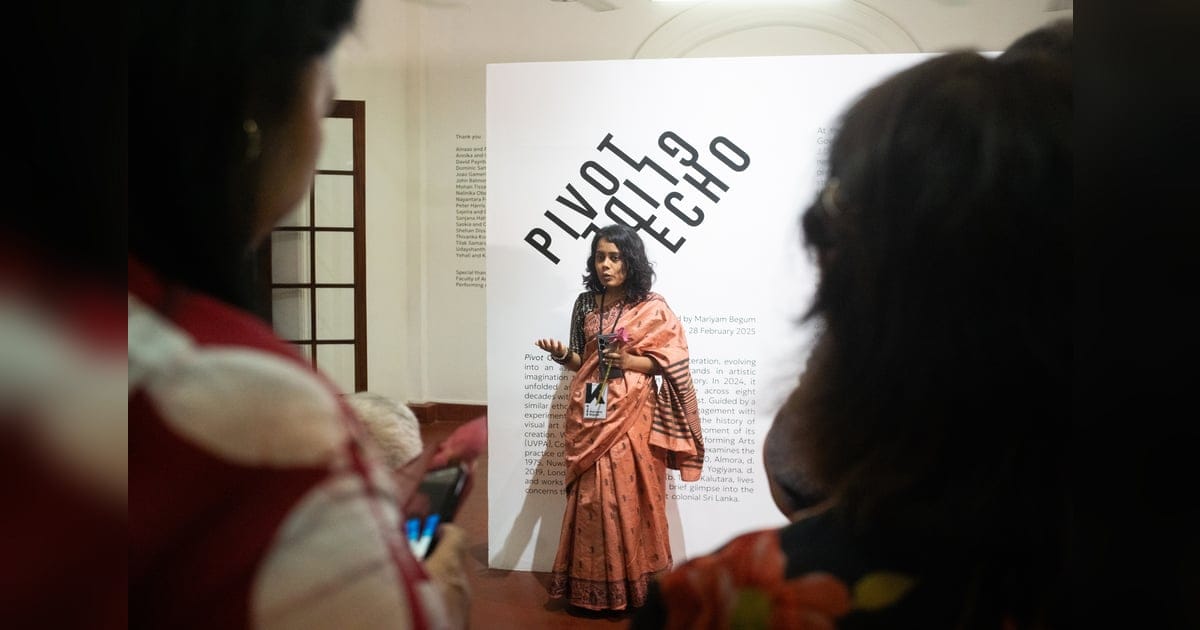News & Blog
Exploring South Asian art: Highlights from KALĀ in Colombo


On a recent evening in Colombo, one was struck by both the simplicity and rich complexity of Hema Shironi’s work. Via humble techniques like hand embroidery on printed fabric, this young Sri Lankan contemporary artist (born in Kandy) tackled weighty themes such as home, displacement and identity in the aftermath of 26 years of civil war in her beautiful island haven. In one of her works depicting a village abode, Shironi stitched a sentence that whispered (rather than screamed), “Now our children can play and study in comfort” — a poignant reminder that having a roof over your head can often be life’s greatest privilege, more so in the times of conflict. Shironi’s powerful series was on display at the contemporary segment of the just-concluded KALĀ South Asia, an annual artistic gathering in Colombo focussed on celebrating South Asian art. Shironi, who was one of the artists of the KALĀ Commune Residency and Open Studio programme (which also included those from neighbouring nations like Ahmed Rasel from Bangladesh, Chandra Bhattacharjee and Pankaj Panwar from India, Ahmed Javed from Pakistan and Seema Sharma Shah from Nepal), admits that her work is mostly based on the stories she has heard from her mother and grandmother.
“For me, home is not something that is fixed. It is constantly moveable. For many young Sri Lankans like myself who grew up under the shadow of war, how can address ever be permanent? So we carry our homes and memories with us,” says Shironi, who usually employs found material like fabrics from different parts of the Ceylon island in her art-making.
In the same room, Ahmed Rasel, a photographer from Bangladesh, had put up a project that examined the effects of urbanisation, climate change and historical memory in his home country. Another series that caught one’s eye was by the Lahore-based Ahmed Javed. Though not as politically charged as Shironi and Rasel’s, Javed’s genius lies in his gifted craftsmanship and materiality, conceptual innovations and a meticulous creative process that involves delving deeper into the subcontinent’s visual history, especially when it comes to exploring the narrative possibilities of Mughal-style miniature paintings. The National College of Arts (NCA, Lahore) graduate has been working on highly stylised and oft-playful portraits of artists in their studio since 2018. One of his works on view at KALĀ cheekily shows his friend, the well-known Pakistani artist Ali Kazim hunched over a painting, lost in thought—it’s an in-joke, a meta study of a miniature artist doffing his hat to another who’s as fascinated with the Mughal-era medium.

Speaking with wknd., Javed says that he often uses neon paints in his work and tries to capture the colourful outfits worn by artists or spotlight eccentric details “to intentionally glorify the sitters.” It seems he wants to dispel the preconceived notion of artists as a bunch of outliers living “poor, miserable lives.” You could very well describe Javed as a documentarian and activist.
As the 32-year-old artist says, “When I started my thesis on miniature painting as a student, I realised the need to fill a couple of historical vacuum — one was that the artists from the Mughal time who were trained in miniature art were breaking so many boundaries in terms of 2Dness, their multiple perspective and stylisation but in the end, the very essence or idea of miniature had evaporated. Either they were using the medium or technique of miniature but that was not the comprehensive art of miniature, so with my work I wanted to bring that back. Anyway, miniature has been a dying art and I wanted to revive it with contemporary content. Secondly, the Mughal miniature was practiced around the 16th till 18th century and it was essentially a form of court art. Since the camera was not invented, the artists used art to document life during the Mughal time, whether it was their lifestyle, rituals, hunting games, festivals or war scenes. Ironically, the talented artists who documented all this for posterity themselves were not documented. That’s why I started this project.”

Javed sounded happy with his time spent in Colombo, as he got a chance to paint Sri Lankan artists in their studios, another exciting step in his continued obsession with miniatures. Apart from the KALĀ Commune residency program curated by Mandira Ranathunga, which offered artists like Ahmed Javed, Shironi and others a platform to “explore, create and connect,” one of KALĀ’s highlights this year included a historical group show mounted at Colombo’s iconic University of Visual and Performing Arts (UVPA). Curated by Mariyam Begum, ‘Pivot Glide Echo’ was a celebration of Sri Lanka’s artistic legacy over a span of eight decades. With works by such masters like Ena de Silva, Tilak Samarawickrema, Laki Senanayake, Dominic Sansoni, JDA Perera, David Paynter and Thamotharampillai Shanaathanan, the exhibition reflected the sheer breadth and diversity of Sri Lankan art. The choice of venue couldn’t have been more apt, as ‘Pivot Glide Echo’ coincided with the University of Visual and Performing Arts’ 75th anniversary. While the exhibition pivoted around trailblazing teachers by engaging closely with three pedagogues from the institution (David Paynter, Tissa Ranasinghe, and HA Karunaratne, who’s considered to be the father of abstract art in Sri Lanka), curator Mariyam Begum says that she also wanted to branch out from these artists and outside the bounds of UVPA to explore “the resonances and echoes across the wider canon of Sri Lankan art history.” While Sri Lankan art remains rich and varied, it is often associated with Colombo’s influential and more popular ’43 Group (featuring 20th century masters like Geoffrey Beling and George Keyt).
For a change, the curators wanted to highlight a broader spectrum of their country’s artistic talent at KALĀ. “Much of Sri Lankan art history has been focused on the ’43 Group and the artists active in the 1990s like Jagath Weerasinghe, Anoli Perera, Chandgraguptha Thenuwara and T Shanaathanan. With the first edition of KALĀ last year, we had an opportunity to explore and celebrate the versatile trajectories taken by some of Sri Lanka’s leading visual arts practitioners and their mentors with Lionel Wendt serving as a catalyst. Guided by a similar ethos, the edition this year expands on an engagement with experimental image-making, while situating the history of visual art in the cultural and socio-political moment of its creation. This time, there was also an attempt to identify some of the resonances Sri Lankan art history shares with the subcontinent at large,” she says. Known for its blessed beaches, ancient Buddhist sites and idyllic tea plantations, Sri Lanka paradoxically has had a tumultuous and violent history, with oppressed yet resilient citizens enduring the impact of internal political strife and religious conflict.

These challenges have deeply shaped the island’s identity, with art emerging as a voice of the common people. Take Chandraguptha Thenuwara. He was among a group of renegades who have actively used the power and beauty of art to counter the ethno-linguistic war that has dominated post-independent Sri Lankan consciousness. Thenuwara often talks about the Black July pogrom of 1983 as being influential to his art and his provocative works at KALĀ bears a testament to how art can serve as an antidote in the times of war and uncertainty. “His untitled series in the current exhibition was created in 1993 thus becoming a visual precursor to a politically motivated series created twenty years later. The work made on a typewriter by Thenuwara, inspired in part by Russian artist Kazimir Malevich, would perhaps also be an early example of a work to be created using mechanical devices in the region,” remarks Begum. KALĀ founding director Saskia Fernando says that the idea behind starting the annual event was to create a platform that would honour modern and contemporary art in South Asia and provide greater visibility to Sri Lanka art while also fostering a dialogue between the island and its South Asian neighbours.

Apart from exhibitions, KALĀ’s programming also included dynamic talk sessions curated by the London-based Art South Asia Project (ASAP). Fernando, who is also the founder of the leading gallery bearing her name in Colombo has championed the local art scene for two decades, helped by her father Udayshanth Fernando who is widely regarded as a patron saint of design and aesthetics in Sri Lanka and is also an avid art collector himself. Saskia Fernando’s goal for KALĀ (a Sanskrit word for ‘art’) is that it will act as a catalyst for growth in this region. “We can only hope to play a role in the wonderful initiatives that are all working towards the promotion of the South Asian art world. I think we would like to encourage community building across our countries and organisations. Our collaborations with institutions including Art South Asia Project, Asia Society and the India Art Fair are perfect examples of how we want to work as a platform — celebrating organisations dedicated to the South Asian art world while providing opportunities for us to discuss subjects that are timely to our region and its diasporas. Sri Lankan art and culture has always been in consistent upward motion, throughout times of crisis, and KALĀ has launched itself at a time when initiatives are thriving locally. The coming decades are hopeful for us all,” explains Fernando.
















